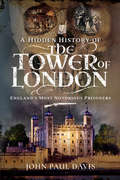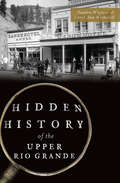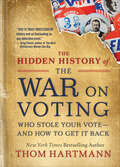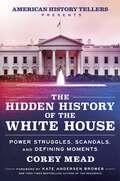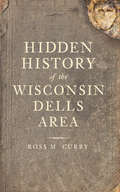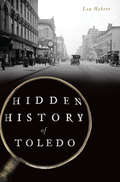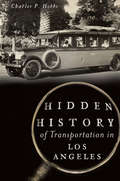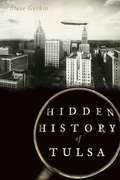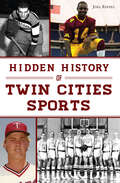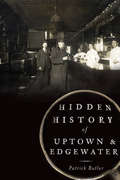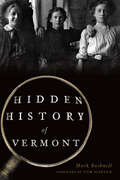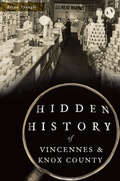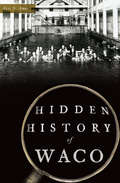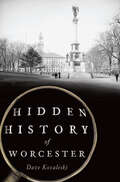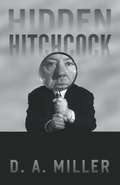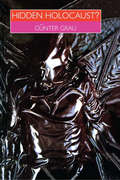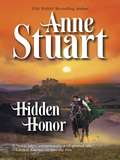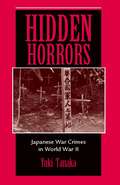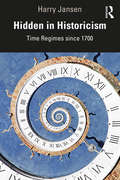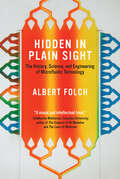- Table View
- List View
A Hidden History of the Tower of London: England's Most Notorious Prisoners
by John Paul Davis“With these incredible and often heartbreaking stories, John Paul Davis clearly demonstrates how the fortress acquired its sinister reputation.” —History . . . the Interesting Bits!Famed as the ultimate penalty for traitors, heretics and royalty alike, being sent to the Tower is known to have been experienced by no less than 8,000 unfortunate souls. Many of those who were imprisoned in the Tower never returned to civilization and those who did, often did so without their head! It is hardly surprising that the Tower has earned itself a reputation among the most infamous buildings on the planet.Beginning with the early tales surrounding its creation, this book investigates the private life of an English icon. Concentrating on the Tower’s developing role throughout the centuries, not in terms of its physical expansion into a site of unique architectural majesty or many purposes but through the eyes of those who experienced its darker side, it pieces together the, often seldom-told, human story and how the fates of many of those who stayed within its walls contributed to its lasting effect on England’s—and later the UK’s—destiny. From ruthless traitors to unjustly killed Jesuits, vanished treasures to disappeared princes and jaded wives to star-crossed lovers, this book provides a raw and at times unsettling insight into its unsolved mysteries and the lot of its unfortunate victims, thus explaining how this once typical castle came to be the place we will always remember as THE TOWER.“The building is as imposing now as it ever was, and the author’s complete and thorough knowledge is imparted in grand style.” —Books Monthly
Hidden History of the Upper Rio Grande (Hidden History)
by Carol Ann Wetherill Sandra WagnerHome to long-forgotten mining towns, defunct fisheries and neglected cabins, the turbulent headwaters of the Upper Rio Grande conceal a largely unknown history. Bob Wills and his Texas Playboys brought their legendary Texas swing to Crooked Creek Canyon’s S Lazy U barn dance, while a comedy of errors unfolded around the ranch’s secret still. Obstetrician Dr. MaryAnn Faunce, the daughter of an abolitionist and suffragette, made house calls as a real-life Dr. Quinn, Medicine Woman. Rough-and-tumble miners drawn to Creede’s silver boom found accommodations ranging from the primitive to the opulent, though none as enduring as the Creede Hotel. Upper Rio Grande native Carol Ann Wetherill and author Sandra Wagner preserve and celebrate the pioneering spirit that defined the early days in this obscure corner of southern Colorado.
The Hidden History of the War on Voting: Who Stole Your Vote—and How To Get It Back (The\thom Hartmann Hidden History Ser. #3)
by Thom Hartmann"Hartmann's history of voter suppression in America is necessary information given current news about voter registration purges and redistricting...a particularly timely topic for an election year, and anyone who is seriously concerned about the survival of American democracy will want to read this book and apply its lessons."—BooklistAmerica's #1 progressive radio host looks at how elites have long tried to disenfranchise citizens—particularly people of color, women, and the poor—and shows what we can do to ensure everyone has a voice in this democracy.In today's America, only a slim majority of people register to vote, and a large percentage of registered voters don't bother to show up: Donald Trump was elected by only 26 percent of eligible voters. Unfortunately, this is not a bug in our system, it's a feature. Thom Hartmann unveils the strategies and tactics that conservative elites in this country have used, from the foundation of the Electoral College to the latest voter ID laws, to protect their interests by preventing &“the wrong people&”—such as the poor, women, and people of color—from voting while making it more convenient for the wealthy and white. But he also lays out a wide variety of simple, commonsense ways that we the people can fight back and reclaim our right to rule through the ballot box.
The Hidden History of the White House: Power Struggles, Scandals, and Defining Moments
by Corey MeadPresented by the hit podcast American History Tellers, The Hidden History of the White House reveals the behind-the-scenes stories of some of the most dramatic events in American history—set right inside the house where it happenedFor more than two centuries, the White House in Washington, DC, has been the stage for some of the most climactic moments in American history. Its walls and portraits have witnessed fierce power struggles, history-altering decisions, shocking scandals, and intimate moments among the First Family, their guests, and the staff.In the signature style of the popular American History Tellers podcast, The Hidden History of the White House places readers in the shoes of historical figures—from power brokers to everyday Americans alike—who lived through pivotal events that shaped America.As a fly on the wall of history, you’ll find yourself immersed in:Andrew Jackson’s disastrous 1829 inauguration, when a mob overran and trashed the White House.Woodrow Wilson’s stroke, which led to his wife Edith serving as shadow president during the final months of his administration.President-elect Abraham Lincoln’s clandestine journey to Washington to dodge an assassination plot on the eve of the Civil War.Winston Churchill’s wartime sojourn at the White House, during which he and FDR developed plans to defeat Germany.Barack Obama’s decision to green-light the Navy SEAL raid that killed Osama bin Laden.Equal parts social, political, and cultural history—written and presented in the accessible and engaging style for which American History Tellers is famous—The Hidden History of the White House offers readers a rare opportunity to live within the halls of the Executive Mansion, and explore some of the extraordinary people and events that made America what it is today.
Hidden History of the Wisconsin Dells Area (Hidden History)
by Ross M. CurryThe history of the Wisconsin Dells area is as unique as its glacier-sculpted landscape. It has been a gathering place for tribal councils, a vacation spot for enthralled tourists and a stopping point for the raftsmen who might have had a little too much of the "Devil's Eyewater" brewed by pioneer Robert Allen. Local expert Ross M. Curry has been chronicling the region, from Baraboo to Lyndon, for almost sixty years. Join him for those chapters of the area's story that he himself has witnessed, and then follow him as he hikes back to a time before the Kilbourn Dam, when towns were lit by gaslight, justice might be enforced by duels or "necktie parties" and hardships had to be outlasted by tightknit families with unshakable faith and their own butter churns.
Hidden History of Toledo (Hidden History)
by Lou HebertToledo's history as a frontier town turned manufacturing powerhouse is well known. However, few know that it was once home to a champion racehorse that galloped into the record books. Many are unaware that East Toledo's verdant urban woodlands sprang from the work of just one man or that a local girl's meteoric rise in Golden Age Hollywood saw her play alongside Groucho Marx. Fewer still have heard of Officer Dell Hair, crime fighter and rhyme maker who walked the beat and walked into the history books as a celebrated cop-poet. These tales and more await as award-winning local broadcaster Lou Hebert shines a light into the forgotten corners of Glass City history.
Hidden History of Transportation in Los Angeles (Hidden History)
by Charles P. HobbsLos Angeles transportation's epic scale--its iconic freeways, Union Station, Los Angeles International Airport and the giant ports of its shores--has obscured many offbeat transit stories of moxie and eccentricity. Triumphs such as the Vincent Thomas Bridge and Mac Barnes's Ground Link buspool have existed alongside such flops as the Santa Monica Freeway Diamond Lane and the Oxnard-Los Angeles Caltrain commuter rail. The City of Angels lacks a propeller-driven monorail and a freeway in the paved bed of the Los Angeles River, but not for a lack of public promoters. Horace Dobbins built the elevated California Cycleway in Pasadena, and Mike Kadletz deployed the Pink Buses for Orange County kids hitchhiking to the beach. Join Charles P. Hobbs as he recalls these and other lost episodes of LA-area transportation lore.
Hidden History of Tulsa (Hidden History)
by Steve GerkinThe story of Tulsa's transformation from a nineteenth-century cow town into the "Oil Capital of the World" has been above ground for years, but a great reservoir of Tulsey Town's heritage has remained beneath the surface. These neglected tales include the dirigible flyover of 1929, the Hominy Indians' victory over the New York Giants and the legendary final performance of Spade Cooley, convicted killer and the self-proclaimed "King of Western Swing." From the horrors of the city's early race riot and the proud legacy of Greenwood (aka Little Africa or Black Wall Street) to Tulsa's iconic landmarks and unforgettable personalities, Steve Gerkin provides an evocative and enjoyable voyage through T-Town's hidden history.
Hidden History of Twin Cities Sports (Sports)
by Joel RippelTwin Cities sports fans are well-versed in disappointment, but the last 120 years of Minneapolis and St. Paul sports have also produced forgotten milestones. Most know of the Vikings' Super Bowl woes and the Twins' record-setting postseason losing streak. Few know that the first full-time college basketball coach originated here and that a Babe Ruth home run record supplanted a local player's achievement. Fewer still know about near misses like John Wooden almost becoming the University of Minnesota basketball coach in 1948 and Billie Jean King turning down an offer to join the Twin Cities' World Team Tennis franchise. Longtime Twin Cities journalist Joel Rippel documents these subjects and other forgotten or unheralded stories.
Hidden History of Uptown and Edgewater (Hidden History)
by Patrick ButlerIf there's any place in Chicago that's been all things to all men, it has to be the corner of the city that is occupied by Edgewater and Uptown. Babe Ruth and Mahatma Gandhi found a place of refuge at the Edgewater Beach Hotel, but the locale has also been a sanctuary for Appalachian coal miners and Japanese Americans released from internment camps. Al Capone reportedly moved booze through a secret tunnel connecting the Green Mill and the Aragon Ballroom, "Burglar Cops" moonlit out of the Summerdale police station and a "Kitchen Revolt" by some not-very-ordinary housewives sent once-invulnerable machine ward boss Marty Tuchow on his way to Club Fed. Ferret out the hidden history of Uptown and Edgewater with veteran beat reporter Patrick Butler in this curio shop of forgotten people and places..
Hidden History of Vermont (Hidden History)
by Mark BushnellDiscover the lively and lesser-known history of the Green Mountain State—illustrations included. Vermont&’s history is marked by fierce independence, generosity of spirit—and plenty of quirky characters and colorful events that have occurred among its steep slopes and fertile valleys. In this lively book, you can: Meet the widow who outwitted Tories and may have spied for the Green Mountain BoysEncounter the family who gained a national following by summoning spiritsDiscover why one governor opposed women's suffrage and how that may have involved spirits of another sortVisit an island retreat where Harpo Marx cheated at croquet and satirist Dorothy Parker wore nothing but a garden hat Historian Mark Bushnell offers a glimpse of the Green Mountain State rarely seen—along with photos and illustrations.
Hidden History of Vincennes & Knox County (Hidden History)
by Brian SpangleThe Battle of Fort Sackville appears in every history of Vincennes and Knox County, yet so much more defines this area. Everyone is familiar with George Rogers Clark, but few know about ordinary but accomplished figures like diplomat Hubbard Taylor Smith and Civil War veteran Joseph Roseman. The Stibbins murder of 1911 and other long-forgotten crimes once shocked the county, and visits by politicians and entertainers, including Buffalo Bill Cody, enthralled residents before quickly slipping from memory. Weather made history, too, such as the destructive hailstorm that pounded northern Knox County in 1907. With the help of rare photographs, local historian and Sun-Commercial columnist Brian Spangle brings to life these stories and more.
Hidden History of Wabash County, Indiana (Hidden History)
by Ron WoodwardTake the road less traveled through Wabash County's forgotten stories and overlooked characters. Bob Printy may have run off to join the circus, but Jocko the monkey decided to make Wabash his home after he escaped a traveling carnival. Discover the story of Chief LeGros and learn what life was like in nineteenth-century Wabash County. Spend some time with Tommy R. Miller, who sacrificed his life caring for fellow servicemen in Vietnam. Author Ron Woodward shares the compelling, little-known history of this Indiana county.
Hidden History of Waco (Hidden History)
by Eric S. AmesSince its establishment in 1849, Waco has grown from a frontier town on the Brazos River to a thriving city of more than 125,000 residents. And in those 171 years, Waco's citizens have seen triumph, tragedy, humor, heartbreak and infamy. Some of those stories garnered widespread attention or became established local lore, but many more have fallen through the cracks. Catch up on the backstory of notorious figures like W.C. Brann, firebrand publisher of the Iconoclast. Discover how one of the longest novels published in the English language was written by a wealthy recluse in a downtown mansion. From the artesian wells of "Geyser City" to the tombs of Telephus Telemachus Louis Augustus Albartus "Tel" Johnson, author Eric Ames offers a chance for a deeper appreciation of Waco's unique history.
Hidden History of Worcester (Hidden History)
by Dave KovaleskiAs the second-largest city in New England, Worcester is well known for its contributions to manufacturing and transportation. However, many other people and events contributed to the building of this city. Timothy Bigelow led a revolution to take back Worcester from British rule almost two years before the Declaration of Independence. Abby Kelley Foster helped establish the first national women's rights convention in Worcester and was a leading voice against slavery. The city was also home to one of the nation's first professional baseball teams, the Worcester Brown Stockings. Join local author Dave Kovaleski as he reveals the stories behind revolutionaries, reformers and pioneers from the "Heart of the Commonwealth."
Hidden Hitchcock
by D. A. MillerNo filmmaker has more successfully courted mass-audience understanding than Alfred Hitchcock, and none has been studied more intensively by scholars. In Hidden Hitchcock, D. A. Miller does what seems impossible: he discovers what has remained unseen in Hitchcock's movies, a secret style that imbues his films with a radical duplicity. Focusing on three films--Strangers on a Train, Rope, and The Wrong Man--Miller shows how Hitchcock anticipates, even demands a "Too-Close Viewer." Dwelling within us all and vigilant even when everything appears to be in good order, this Too-Close Viewer attempts to see more than the director points out, to expand the space of the film and the duration of the viewing experience. And, thanks to Hidden Hitchcock, that obsessive attention is rewarded. In Hitchcock's visual puns, his so-called continuity errors, and his hidden appearances (not to be confused with his cameos), Miller finds wellsprings of enigma. Hidden Hitchcock is a revelatory work that not only shows how little we know this best known of filmmakers, but also how near such too-close viewing comes to cinephilic madness.
The Hidden Holocaust?: Gay and Lesbian Persecution in Germany 1933-45
by Günter GrauThe persecution of lesbians and gay men by the Nazis is a subject that has been constantly debated during the last decade, providing a theme for books, articles, and plays. Until recently the discussion has remained speculative: most of the relevant documents were stored in closed East German archives, and access was denied to scholars and researchers.As a result of the unification of East and West Germany, these archives are now open. Hidden Holocaust, by the German scholars Gunter Grau and Claudia Shoppmann of Humboldt Uinversity, Berlin, demonstrates that the eradication of homosexuals was a declared gol of the Nazis even before they took power in 1933, and provide proof of the systematic anti-gay campaigns, the methods used tjo justify discrimination, and the incarceration mutilation and murder of gay men and women in Nazi concentration camps. A chilling but groud-breaking work in gay and lesbian studies.
Hidden Honor
by Anne StuartIndependent and headstrong, Elizabeth of Bredon wants only to become a nun, but her journey to the convent of St. Anne's threatens her choice. It's not the escort of holy friars who tempt her, but the man they are taking to do penance for his many sins. Elizabeth has heard whispers about Prince William's treatment of women-the king's only son is a man well schooled in deception, cruelty and murder-yet she cannot entirely resist his charms.But when the journey takes a treacherous turn, masks of deception fall and there is no safe place but in the wicked prince's arms. With treachery drawing near, they are soon racing against time, murderous revenge...and their own sinful desires.
Hidden Horrors
by Yuki TanakaThis book documents for the first time previously hidden Japanese atrocities in World War II, including cannibalism; the slaughter and starvation of prisoners of war; the rape, enforced prostitution, and murder of noncombatants; and biological warfare experiments. The author describes how desperate Japanese soldiers consumed the flesh of their own comrades killed in fighting as well as that of Australians, Pakistanis, and Indians. Another chapter traces the fate of 65 shipwrecked Australian nurses and British soldiers who were shot or stabbed to death by Japanese soldiers. Thirty-two other nurses, who landed on another island, were captured and sent to Sumatra to become "comfort women”--prostitutes for Japanese soldiers. Tanaka recounts how thousands of Australian and British POWs died in the infamous Sandakan camp in the Borneo jungle in 1945. Those who survived were forced to endure a tortuous 160-mile march on which anyone who dropped out of line was immediately shot. Only six escapees lived to tell the tale. Based on exhaustive research in previously closed archives, this book represents a landmark analysis of Japanese war crimes. The author explores individual atrocities in their broader social, psychological, and institutional milieu and places Japanese behavior during the war in the broader context of the dehumanization of men at war--without denying individual and national responsibility.
Hidden Horrors
by Yuki TanakaThis book documents for the first time previously hidden Japanese atrocities in World War II, including cannibalism; the slaughter and starvation of prisoners of war; the rape, enforced prostitution, and murder of noncombatants; and biological warfare experiments. The author describes how desperate Japanese soldiers consumed the flesh of their own comrades killed in fighting as well as that of Australians, Pakistanis, and Indians. Another chapter traces the fate of 65 shipwrecked Australian nurses and British soldiers who were shot or stabbed to death by Japanese soldiers. Thirty-two other nurses, who landed on another island, were captured and sent to Sumatra to become "comfort women”-prostitutes for Japanese soldiers. Tanaka recounts how thousands of Australian and British POWs died in the infamous Sandakan camp in the Borneo jungle in 1945. Those who survived were forced to endure a tortuous 160-mile march on which anyone who dropped out of line was immediately shot. Only six escapees lived to tell the tale. Based on exhaustive research in previously closed archives, this book represents a landmark analysis of Japanese war crimes. The author explores individual atrocities in their broader social, psychological, and institutional milieu and places Japanese behavior during the war in the broader context of the dehumanization of men at war-without denying individual and national responsibility.
Hidden Horrors
by Yuki TanakaThis book documents for the first time previously hidden Japanese atrocities in World War II, including cannibalism; the slaughter and starvation of prisoners of war; the rape, enforced prostitution, and murder of noncombatants; and biological warfare experiments.The author describes how desperate Japanese soldiers consumed the flesh of their own comrades killed in fighting as well as that of Australians, Pakistanis, and Indians. Another chapter traces the fate of 65 shipwrecked Australian nurses and British soldiers who were shot or stabbed to death by Japanese soldiers. Thirty-two other nurses, who landed on another island, were captured and sent to Sumatra to become "comfort women"-prostitutes for Japanese soldiers. Tanaka recounts how thousands of Australian and British POWs died in the infamous Sandakan camp in the Borneo jungle in 1945. Those who survived were forced to endure a tortuous 160-mile march on which anyone who dropped out of line was immediately shot. Only six escapees lived to tell the tale.Based on exhaustive research in previously closed archives, this book represents a landmark analysis of Japanese war crimes. The author explores individual atrocities in their broader social, psychological, and institutional milieu and places Japanese behavior during the war in the broader context of the dehumanization of men at war-without denying individual and national responsibility.
Hidden Horrors
by Yuki TanakaThis book documents for the first time previously hidden Japanese atrocities in World War II, including cannibalism; the slaughter and starvation of prisoners of war; the rape, enforced prostitution, and murder of noncombatants; and biological warfare experiments.The author describes how desperate Japanese soldiers consumed the flesh of their own comrades killed in fighting as well as that of Australians, Pakistanis, and Indians. Another chapter traces the fate of 65 shipwrecked Australian nurses and British soldiers who were shot or stabbed to death by Japanese soldiers. Thirty-two other nurses, who landed on another island, were captured and sent to Sumatra to become "comfort women"-prostitutes for Japanese soldiers. Tanaka recounts how thousands of Australian and British POWs died in the infamous Sandakan camp in the Borneo jungle in 1945. Those who survived were forced to endure a tortuous 160-mile march on which anyone who dropped out of line was immediately shot. Only six escapees lived to tell the tale.Based on exhaustive research in previously closed archives, this book represents a landmark analysis of Japanese war crimes. The author explores individual atrocities in their broader social, psychological, and institutional milieu and places Japanese behavior during the war in the broader context of the dehumanization of men at war-without denying individual and national responsibility.
The Hidden Horticulturists: The Untold Story of the Men Who Shaped Britain's Gardens
by Fiona DavisonIn 2012, while working at the Royal Horticultural Society's library, Fiona Davison unearthed a book of handwritten notes that dated back to 1822. The notes, each carefully set out in neat copperplate writing, had been written by young gardeners in support of their application to be received into the Society's Garden. Among them was an entry from the young Joseph Paxton, who would go on to become one of Britain's best-known gardeners and architects. But he was far from alone, and now, for the first time, the stories of the young, working-class men who also played a central role in the history of British horticulture can be told. Using their notes, Fiona Davison traces the stories of a selection of these forgotten gardeners whose lives would take divergent paths to create a unique history of gardening. The trail took her from Chiswick to Bolivia and uncovered tales of fraud, scandal and madness—and, of course, a large number of fabulous plants and gardens. This is a celebration of the unsung heroes of horticulture whose achievements reflect a golden moment in British gardening, and continue to influence gardeners today..
Hidden in Historicism: Time Regimes since 1700
by Harry JansenHidden in Historicism considers how the nineteenth-century philosophy of historicism depicts three "forgotten time regimes": a time of rise and fall, an ambiguous time of synchronicity of the non-synchronous, and a time in which decisive moments dominate. Before the eighteenth century, time was past-oriented. This inversed in the Enlightenment, when the future became dominating. Today, this time of progress continues to be embraced as a "time of the modern". Yet, inequality, increasing violence and climate change lead to doubts over a bright future. In this book, Harry Jansen moves away from the heritage of Reinhart Koselleck and his single time of the modern towards a historicist, threefold temporal approach to history writing. In the time regime of the twenty-first century past, present and future coexist. It is a heterogeneous time that takes on the three forms of historicism. Jansen’s study shows how all three times exist together in current historiography and contribute to a better understanding of the world today. Based on the idea that an incarnated time rules everything that happens it reality, the book offers a fresh perspective on the ongoing discussion about time and time regimes in contemporary philosophy and theory of history for students and scholars, both time specialists and the non-specialist.
Hidden in Plain Sight: The History, Science, and Engineering of Microfluidic Technology
by Albert FolchStories behind essential microfluidic devices, from the inkjet printer to DNA sequencing chip.Hidden from view, microfluidics underlies a variety of devices that are essential to our lives, from inkjet printers to glucometers for the monitoring of diabetes. Microfluidics—which refers to the technology of miniature fluidic devices and the study of fluids at submillimeter levels—is invisible to most of us because it is hidden beneath ingenious user interfaces. In this book, Albert Folch, a leading researcher in microfluidics, describes the development and use of key microfluidic devices. He explains not only the technology but also the efforts, teams, places, and circumstances that enabled these inventions. Folch reports, for example, that the inkjet printer was one of the first microfluidic devices invented, and traces its roots back to nineteenth-century discoveries in the behavior of fluid jets. He also describes how rapid speed microfluidic DNA sequencers have enabled the sequencing of animal, plant, and microbial species genomes; organs on chips facilitate direct tests of drugs on human tissue, leapfrogging over the usual stage of animal testing; at-home pregnancy tests are based on clever microfluidic principles; microfluidics can be used to detect cancer cells in the early stages of metastasis; and the same technology that shoots droplets of ink on paper in inkjet printers enables 3D printers to dispense layers of polymers. Folch tells the stories behind these devices in an engaging style, accessible to nonspecialists. More than 100 color illustrations show readers amazing images of microfluids under the microscope.
